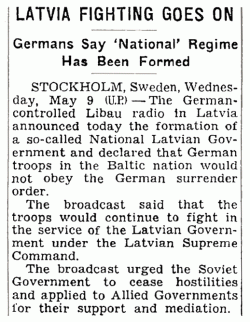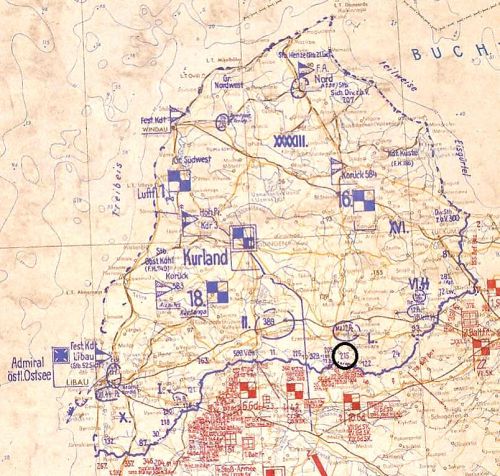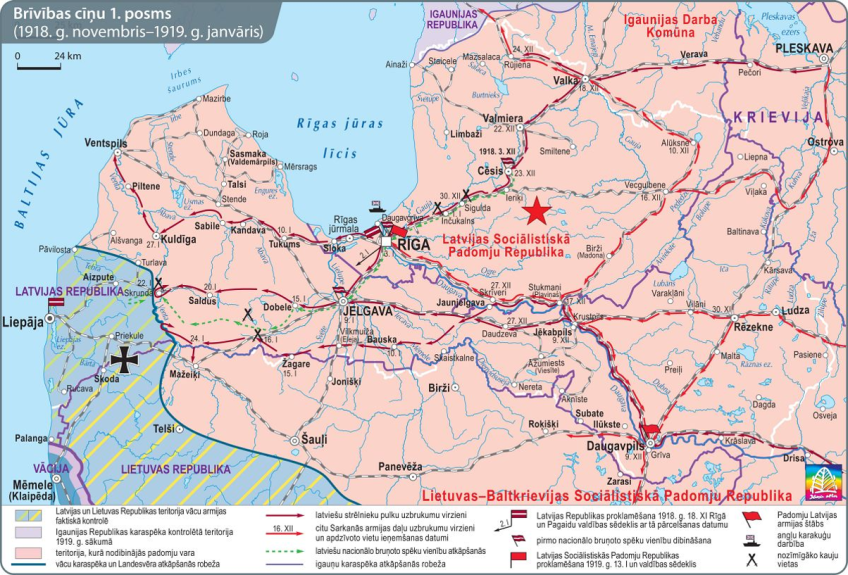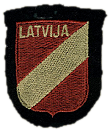
Nazi Germany mobilized some 110–150,000 Latvian men into combat service, including the Latvian Legion, aka Waffen grenadier divisions "der SS" (of the SS), to fight against the Red Army on the Eastern Front.1 By the end of the war, the Germans had illegally ordered every Latvian male born after 1905 conscripted.
Latvian forces held out to the end of the war in Courland2, the only territory on the Eastern Front not re-occupied3 by the Red Army. As circumstances became desperate for Nazi Germany, Berlin had even dangled the return of Latvian civilian authority in exchange for continued Latvian resistance against the Soviet advance. In early 1945, Latvian representatives traveled to Dresden for discussions.4 But as their train arrived at 4:30 in the morning in Freital (the last stop before Dresden), they could see Dresden in flames.56 The Latvians returned home empty-handed. The British disappointed more. The evacuation by sea which they radioed the Latvians in Courland to await never materialized. The Soviets treated captured Latvians as traitors: shot or sent to the Gulag.

October 1944 and May 1945 German records shown by solid blue and dotted red lines, respectively. Advancing the front cost the Red Army 394,000 casualties7, and 2,651 tanks, 900 artillery pieces, and 1,440 machine guns lost.8
Latvians achieved independence following World War I after holding far less territory (under de facto German control). (see below)

The Soviet map overstates territorial gains. Post-Soviet Russian scholarship generally aligns with the Latvian on casualties, indicating 160,948 killed from mid-February to May 1945 alone.9
Efraim Zuroff has maintained that the Latvians' fight against the Red Army was a fight for Nazi victory, and that the only other available — and moral — road to any possible return of sovereignty was through Soviet reoccupation—meaning more mass deportations, more murders, societal and environmental damage,...
The Latvians’ desire to fight against the Soviets and prevent a second Communist occupation was understandable, but their choice of partners was morally and practically deeply flawed. By joining the Latvian Legion, which was part of the Waffen-SS, their service was spent fighting for a victory of the most genocidal regime in human history, and even worse was totally for naught. The Nazis, in fact, had absolutely no intention of granting Latvia, or any of the Baltic countries, independence. Thus ironically, it is only because Germany was defeated in World War II, that Latvian sovereignty could ultimately be restored.10
Latvia was occupied. "Joining" the Legion was at Nazi gunpoint. Regardless, the Germans were the only possibility, not a choice, for arms against the prior invader. Within living memory Latvians had achieved independence holding no territory themselves at the end of WWII. Indeed, on November 18, 1918, the day Latvians declared independence, Latvia was under complete German occupation. The provisional Latvian government wasn't even on dry land, instead, ensconced on the Saratov in Liepāja harbor, protected by two flanking British ships. Following the Bolshevik invasion that December, Russia gained control over the vast majority of Latvia. By January 1919, German control had been reduced to a small corner on the Baltic Sea coast.
Why did Latvians believe they could regain freedom after WWII? Because under the circumstances just described, Latvians had driven both Russians and Germans from their homeland — as enshrined in Legion song.
...
I shall depart to the east ...
You'll not see me again ...
Never again, Never again.We'll beat the flea-infested ones [Russians] ...
And after, the blue-grey ones [Germans] ...
Again and again, again and again.May the Latvian sun never set,
Never ever, never ever
May the Latvian saber never rust
Never ever, never ever.
Efraim Zuroff's contention that a rerun of seven centuries of brutal subjugation was the only option, that the only falsely-labeled "choice" lay in either the German or Russian yoke, is ignorant, insulting, and prejudiced. Over 200,000 Latvians fought in the armies of the occupiers in WWII, but for the cause of neither. Half died.
Indicative of the challenge Latvians face in the telling of their history, some scholars have even absurdly contended Latvians chose sides and fought a "civil war" in the midst of WWII. The USSR and Nazi Germany were both invaders, both enemies. Only the Latvian Mercantile Marine served by choice in WWII, in the Allied cause.
The map below shows areas of Russian Bolshevik and German control, November, 1918 through and as of January, 1919.

| 1 | Zaķe, Ieva. American Latvians: Politics of a Refugee Community. Transaction Publishers. 2011. p.92. Estimates range to 140,000 for the total mobilized. This includes both combat infantry and support units. Legionnaires specifically in combat roles numbered some 52,000 to 56,000, and were operationally integrated into the Wehrmacht. |
| 2 | In Latvian, Kurzemes cietoksnis (Courland Fortress) or Kurzemes katls (Courland Cauldron) |
| 3 | The USSR had invaded and occupied Latvia for a year prior to Nazi Germany's invasion and occupation. |
| 4 | Dresden was chosen as the location for the Latvian National Council to meet with the Germans because it had, as yet, not suffered aerial bombardment. |
| 5 | Some 40% of the bombs dropped were incendiary. Napalm was invented for bombing Germany, and was tested to maximize damage to traditional German residential structures. |
| 6 | "Only in the afternoon was a separate locomotive delivered also for our small contingent, and at 4:30 we arrived at Freital, the last stop before Dresden. There we find out that Dresden has suffered terribly and is all in flames. Even though the city-destroying fire could be seen from Freital, we nevertheless decided to send scouts to Dresden, which Brigadier-Colonel Silgailis took upon himself to lead." — Diary of Rudolfs Bangerskis, our translation. |
| 7 | Total killed, wounded, and captured. |
| 8 | Švābe, Latvju Enciklopedija, Kurzemes cietoksnis (Courland fortress). In contrast, Soviet history contends the Red Army bypassed Courland once it was cut off, and minimizes casualties. (One Latvian soldier's diary recording the interrogation of a Russian prisoner of war noted Soviet casualties were being under-reported by a factor of four.) |
| 9 | Krivosheyev, Grigoriy F., ed. (2001). Россия и СССР в войнах XX века: Потери вооруженных сил. Статистическое исследование [Russia and the USSR in the Wars of the Twentieth Century: Losses of the Armed Forces. A Statistical Study] (in Russian). Moscow: OLMA-Press. |
| 10 | Efraim Zuroff's opinion piece published at www.jpost.com/ |
| 11 | At https:// |
